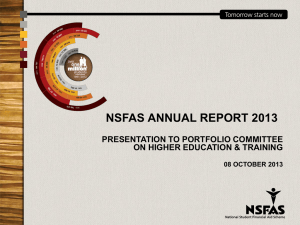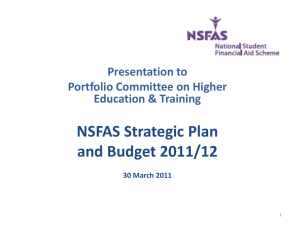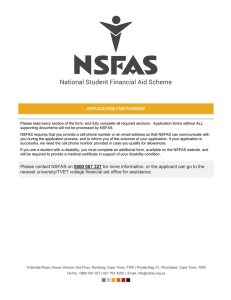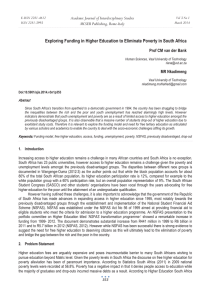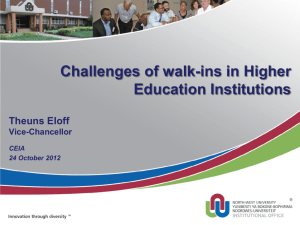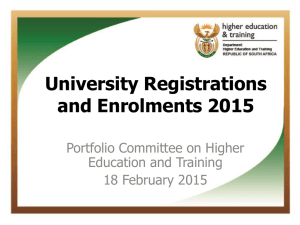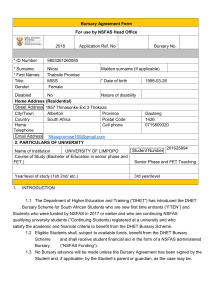Budget - Parliamentary Monitoring Group
advertisement
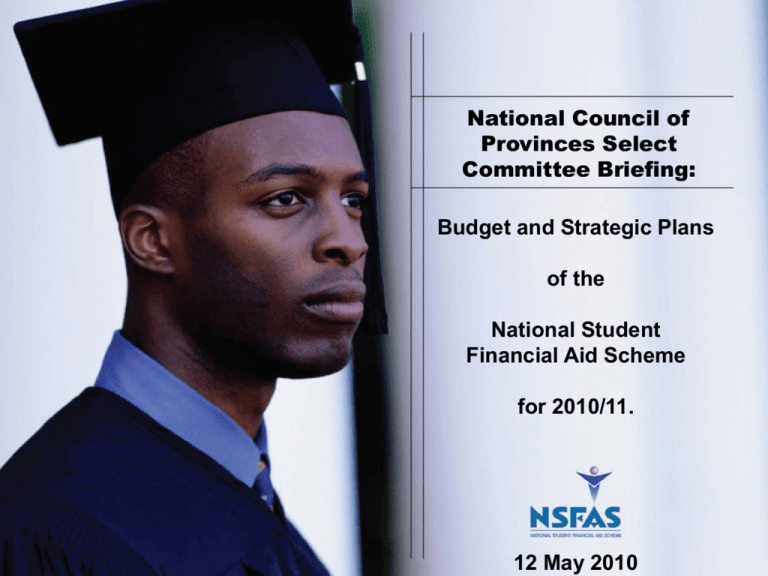
National Council of Provinces Select Committee Briefing: Budget and Strategic Plans of the National Student Financial Aid Scheme for 2010/11. 12 May 2010 History of NSFAS National Student Financial Aid Scheme Act 56/1999 NSFAS took over operations of TEFSA Mandate = to provide financial aid to academically deserving and financially needy students to pursue higher education and training Key service offerings from NSFAS STUDENT * Providing information about opportunities * Providing funding for studies * Recovering loan funding once studies are completed/terminated INSTITUTION *Providing funding allocation for assisting students with grants * Providing training and support in administering the grants * Monitoring how well institutions are using the funding DONORS / FUNDING * Providing a channel for the management of funds for loans and bursaries * Recovering loan funding once student completes/terminates studying *Providing reporting on funding Total Budget for 2010/2011 R’000 Loan and bursary allocations Administration TOTAL 2010/2011 2009/2010 3 346 646 3 003 942 78 093 67 098 3 423 639 3 071 040 Provincial Allocation for student funding Loans FET Bursaries Other bursaries Eastern Cape R264m R36m R 86m Free State R132m R11m R 45m Gauteng Province R826m R79m R143m KwaZulu Natal R402m R56m R 86m Limpopo Province R189m R48m R 44m Mpumalanga Province - R25m R 2,3m Northern Cape - R 6m R 8,4m North West Province R 72m R21m R 32m Western Cape R268m R33m R 93m NOTE: - Other Bursaries = Funza Lushaka and Disability - Gauteng figures include all UNISA allocations no matter where student resides Ministerial Review of NSFAS Proposals regarding funding for students Review acknowledges need to increase funding in order to provide access to more students and the various proposals put forward include: •Progressive introduction of free higher education •Expanding support to include students from lowand middle-income working families •Addressing the 700 000 youth not in education, employment or training •Expanding financial aid for students in FET sector – beyond the National Certificate (Vocational) programmes only NSFAS: Growth in recent years R’000 2005/06 2006/07 2007/08 2008/09 1 237 283 1 384 485 1 918 290 2 559 530 Expenditure 513 463 442 508 941 023 1 431 572 Total Assets 3 798 164 4 713 455 5 692 336 6 840 974 Revenue It should be noted that during the above period and preceding the NSFAS received unqualified audit opinion reports. STRATEGIC GOALS 2010/2011 Strategic goals Goal 1: Expanding the pool of funds available for disbursement as student loans and bursaries Maximise the recovery of outstanding loans from all eligible debtors employed in both the formal and informal sectors of the economy Promote the undergraduate funding service which NSFAS can provide to current and prospective donors Raise new funding for undergraduate study from both public and private sector for targeted students and targeted programmes Promote partnerships with donors on specialised projects to build a resource of funds for students GROW THE MONEY Initiatives planned to achieve Goal 1 Review of loan book Growing the funds under administration, e.g. Corporate Review of debt recovery options • Blacklisting’ of debtors – concerns raised in Ministerial Review Report are already receiving attention from NSFAS Expand number of 1st tier NGO partners • Greater number of students with a range of support services • 1st Tier NGO budget: R9.7 million Strategic goals Goal 2: Effectively managing the institutional utilisation of funds administered by NSFAS in any given year Maximise the utilisation of allocated donor funds per HEI Greater support for/facilitation of the competency and efficiency of HEI staff in Financial Aid Offices MANAGE THE SPEND Initiatives planned to achieve Goal 2 Intensify communication with HEIs regarding reporting on utilisation • Successes in 2009/10 year EXAMPLES FUND 2009/10 UTILISATION 2008/09 UTILISATION DoHET Loan Monies 99% 97% FET Bursaries 99% 95% Disability Funding 87% 38% Drive HEIs to apply NSFAS process for payment of registration fees • Up to 30% of total annual allocation can be claimed upfront from NSFAS o 13 of the 23 Universities applied this policy during 2010 registration NOTE: Ministerial Review Committee Report highlights registration fee issue as a concern – need not be a problem, though, because of the above arrangement Initiatives planned to achieve Goal 2 Tightening reporting and submission of claims deadlines Ongoing training of Financial Aid Office staff (Budget: R0.5 million) • BUT some HEIs face challenges regarding staff turnover, appointing staff etc. LOAN AND BURSARY BUDGETS (R,000) 2010/2011 2009/2010 DE (General) 2 064 283 1 820 835 DE (Teacher) 91 626 85 499 DE (Students with Disabilities) 74 300 50 000 DE (SAICA) 25 770 18 000 Funza Lushaka 424 000 400 000 Private Sector 15 000 15 000 FET Colleges 318 000 300 000 Strategic goals Goal 3: Strengthening internal efficiencies in the processing of student awards/claims to ensure that funding reaches target population Improve processing efficiency for loan and bursary agreements Reduce the administration demand on FAOs and NSFAS data capturing units by enhancing electronic systems (HEIs only) Provide a high level of information technology infrastructure and services to all institutions PUSH THE PAYMENTS Initiatives planned to achieve Goal 3 Restructure within NSFAS operations area to allow for separate focus on processing of loans and bursaries respectively – geared to speed up turnaround times Electronic Loan Agreement Forms (“ELAFs”) at 3 pilot site universities to be evaluated for the project Implement the distribution of statements to debtors by SMS Implement Mobi site to allow students to access the NSFAS website via cellular phone in order to view statements, update contact details, etc. Plan for the development of ITS system to allow for electronic reporting by Financial Aid Offices. Postage, stationery and ICT services - Budget: R11.8 million Strategic goals Goal 4: Strengthening the quality of internal management and operations in line with changing funding patterns Provide a high level of information technology both internally and with all donors Ensure that the organisational risk, governance and regulatory requirements environment is assessed and risk minimised across the NSFAS value chain Ensure the NSFAS human resource management and administration practices are in accordance with best practices MANAGE THE SYSTEM Initiatives planned to achieve Goal 4 Operational risk, governance and compliance (Internal/External Audit Budget: R6,2 million) • Implementation of Enterprise Risk Management (ERM) • Organisational and Stakeholder Risk Assessments o Operational and IT Risk Based Audits as an outflow from the Risk Assessments • Detailed Organisational and IT Governance and Regulatory Reviews • Internal Audit co-sourcing rollout – started • Compliance Audits of all 23 HEIs and Implementation of Compliance Audits of FETCs • Implementation and monitoring of Fraud Prevention, Business Continuity and new Supply Chain Management/Procurement Strategies and Plans Initiatives planned to achieve Goal 4 Human Resources (Salary budget: R28 million) • Performance management system for all staff – work in progress • Skills audit – in progress IT developments (Budget: R4,6 million) • ACCPAC rollout continues • Systems development to create separate systems for loans vs. bursaries, universities vs. FETC • Development of portal services for institutions and donors Strategic goals Goal 5: Effectively communicating and managing the relationship with all NSFAS stakeholder groups and targeted audiences Improve awareness of undergraduate funding opportunities available through NSFAS amongst current and prospective students in rural and urban South Africa, using and testing alternative channels of communication Engage with HEIs, schools, liaison officers and financial aid offices iro marketing opportunities SPREAD THE MESSAGE Initiatives planned to achieve Goal 5 Direct and indirect communication initiatives with target audiences • Large events in major centres • Use of targeted media, including radio (to reach rural areas) • SMS facility for queries from learners to be expanded • Participating in career exhibitions, open days and community events • School visits – focus on rural areas Testing communication initiatives • Survey students regarding knowledge of NSFAS • Done in February/March 2010 during university registration Budget: R12,2 million Strategic goals Goal 6: Undertaking research that informs the effective utilisation of available funds and serves to advise the Minister on matters related to student financial aid Strengthen policy and advisory support through the development of analytical reports on the impact of the NSFAS Collaborate and consult with stakeholders in the higher education sector to inform policies and ensure co-ordinated responses to matters related to student financial aid Address the responsiveness of the student and institutional funding framework to ensure that deserving students are funded at the institution of choice KNOW THE INDUSTRY Initiatives planned to achieve Goal 6 Relationship building with organisations in higher education sector, e.g. CHE, HESA, CAO Enhancements to the Allocations Model and Means Test – will be informed by Ministerial Review recommendations Strengthening management information systems to assist with strategic planning and policy development Budget: R0.6 million Q&A
